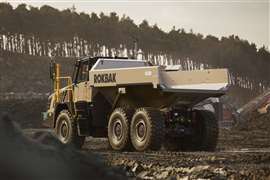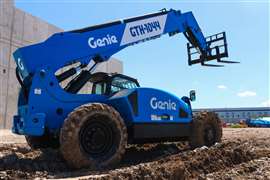Read this article in Français Deutsch Italiano Português Español
Why Trump’s return means a renewed focus on internal combustion engines
18 February 2025
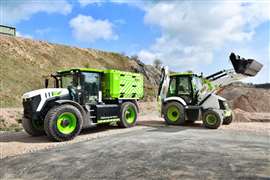 JCB’s hydrogen refueller refuels a hydrogen-powered backhoe loader (Image courtesy of JCB)
JCB’s hydrogen refueller refuels a hydrogen-powered backhoe loader (Image courtesy of JCB)
The buzz around the electrification of both on-road and off-highway vehicles and machinery has dominated the conversation for the past few years.
In many countries that has been driven by plans to cut CO2 emissions, supported by government policies and funding.
The US under President Joe Biden was no different. But the country is now moving in a very different political direction following the return of President Donald Trump.
Trump signed several executive orders on the day of his inauguration that reversed the policies of the previous administration. These included several that affect vehicle electrification and the drive to net zero.
 Neste MY Renewable Diesel is now available in New Jersey at K.W. Rastall Oil’s North Brunswick, N.J., truck stop. (Photo: K.W. Rastall Oil)
Neste MY Renewable Diesel is now available in New Jersey at K.W. Rastall Oil’s North Brunswick, N.J., truck stop. (Photo: K.W. Rastall Oil)
The actions, combined with future Trump administration policies, could set the stage for a renewed focus on internal combustion engines, including those that power construction equipment.
“The previous four years were very heavily focused on climate change and reducing greenhouse gas emissions in every possible way,” Allen Schaeffer, executive director of the Engine Technology Forum, told Construction Briefing’s sister publication Power Progress. “And they had the monies and policies to really drive that. What you saw [on inauguration day] with the incoming administration was a bit of a reversal.”
“That sort of energy policy underscores the importance of continued innovation and development of advanced internal combustion engines,” he said.
Investments that look beyond just the reduction of greenhouse gas emissions, such as those focused on internal combustion engine fuel efficiency, now look likely to take precedence, he added.
Alternative fuels in the mix
One major area that engine and equipment manufacturers alike are expected to devote their attention to is alternative fuels, said Schaeffer.
“Fuels is at the top of that list. I think we’ve seen that, from the renewable fuel perspective over the last few years, how much that’s grown and how much that’s been a significant part of California and their ability to reduce carbon emissions because of their low carbon fuel standard, which requires increasing percentages of low-carbon fuels into the mainstream fuel pool,” Schaeffer said.
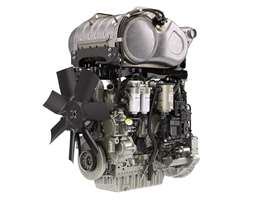 Perkins is collaborating with Equipmake and Loughborough University to develop and produce an advanced multi-fuel “drop-in” hybrid integrated power unit based on the 7 L Perkins 1200 Series. (Photo: Perkins)
Perkins is collaborating with Equipmake and Loughborough University to develop and produce an advanced multi-fuel “drop-in” hybrid integrated power unit based on the 7 L Perkins 1200 Series. (Photo: Perkins)
In California, renewable diesel, which can produce up to 80% lower carbon emissions than fossil diesel, now makes up more than 75% of the diesel fuel pool.
“Changing out the fuel for the engines that we have hopefully will be part of what we might say is a new energy policy from this administration,” Schaeffer said. “Let’s look at innovative fuels and technology in a different way.”
Engine manufacturers have made significant technological leaps in the past but the problem now is that they may be running out of room for further innovation. Switching to alternative fuels potentially unlocks further gains.
When Washington-based fuel maker Advanced Refining Concepts (ARC) recently introduced two new diesel fuel formulations, managing partner Peter Gunnerman said, “Engine manufacturers are at their limits trying to improve efficiency and emissions from standard diesel. It’s long past due time to redesign the fuel side.”
US-based engine and equipment manufacturers hope that the Trump administration will provide a better renewable fuels policy than Biden’s did, which Schaeffer noted would be critical to further investment in the technology.
“I think there’s been a great frustration the last four years from the biofuels industry about the Biden administration’s lack of growth policies for the renewable fuel standard,” Schaeffer said. “If you really were looking at freight sustainability and decarbonisation, you’d look at all the different approaches. That was one that they never really tended to.”
Hydrogen ICEs’ moment?
Hydrogen for internal combustion is an alternative fuel that may finally be coming into its own after years of uncertainty, Schaeffer said.
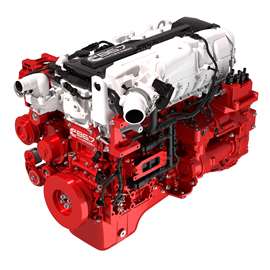 Cummins B6.7H hydrogen engine (Photo: Cummins)
Cummins B6.7H hydrogen engine (Photo: Cummins)
“It used to be a big joke that hydrogen was right around the corner. Honestly, in the last year, it really felt like the corner has been turned and we see some really interesting developments there from companies like Cummins and others. JCB has a hydrogen technology out there now. Caterpillar has hydrogen. [There are] dual fuel blending applications, etc,” he said.
“Companies have a huge interest in providing their customers with more options. Certainly, a hydrogen internal combustion engine vehicle checks a lot of boxes. [It uses] the same engine architecture components. People know how to service these kinds of engines. We’re again just switching out the fuel to a different kind of fuel.”
Nonetheless, there are still challenges and one of the main ones will be a reliably hydrogen fuelling network.
That will be a prerequisite for the wider adoption of hydrogen internal combustion engines.
There’s also a question of whether there will be more money available from US authorities to develop the technology further.
“That’s a tricky one because those investments [in hydrogen] came from the Biden administration’s program. I think they’ve spent pretty much all of that,” Schaeffer said, expressing doubt that additional funding for hydrogen will be available under the Trump administration.
STAY CONNECTED


Receive the information you need when you need it through our world-leading magazines, newsletters and daily briefings.
CONNECT WITH THE TEAM








